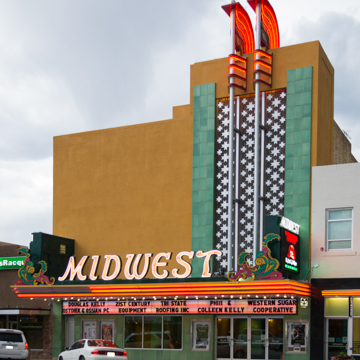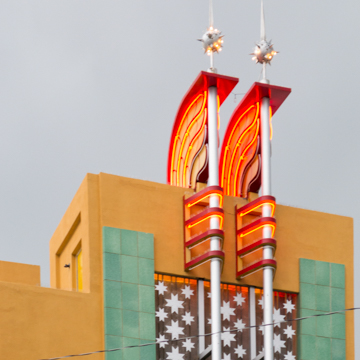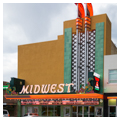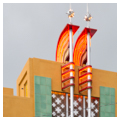Before the rise of the suburban multiplex, the architecture of motion picture theaters frequently embodied the flamboyance of the films themselves. Located in the center of Scottsbluff’s downtown commercial district, the Midwest Theater provides a bit of drama to the streetscape.
Built in 1946 on the site of its predecessor, the Egyptian Theater (which had been destroyed by fire the previous year), the Midwest Theater is a rectangular, two-story brick structure faced with ivory-colored stucco on the second level. Though by the 1940s Art Deco was no longer new, in Scottsbluff the theater still seemed almost futuristic in its use of materials like aluminum and stainless steel. The primary facade has a 50-foot canopy supporting the theater’s name outlined with neon lights and decorative scrolls at the ends. But the signature feature of the facade is a stainless steel and aluminum tower rising sixty feet above the theater’s entrance. A bank of aluminum stars backed by flashing spotlights animates the vertical center of the tower. Positioned several feet in front of this display, two aluminum poles rise the full height of the tower and are topped by stylized wings outlined with neon lights and two starburst spheres. Inside, the auditorium is a memorable blend of light, color, and ornamentation. The stage and movie screen are embraced by a layered valence above the screen and gigantic three-dimensional plaster scrolls on either side that rise majestically from the floor to a height of twenty-five feet. Colorful painted murals continue the floral theme on the auditorium’s walls and ceiling.
The advent of multi-screen theater complexes, electronic entertainment devices, urban renewal, and suburban migration all contributed to the loss of historic motion picture theaters. Such might have been the fate of the Midwest Theater when the final film was shown in 1996 and the building was donated to the Oregon Trail Community Foundation. Shortly after, however, a group of local citizens organized Friends of the Midwest Theater to manage the operation of the theater. Today the Midwest Theater is a multipurpose cultural venue for citizens of Scottsbluff and the surrounding region that accommodates a variety of activities including film, performing arts, and community programs and receptions. The iconic building continues to display a remarkably high degree of exterior and interior integrity.
References
Hurst, Robert, “Midwest Theater,” Scotts Bluff, Nebraska. National Register of Historic Places Registration Form, 1997. National Park Service, U.S. Department of the Interior, Washington, DC.

















